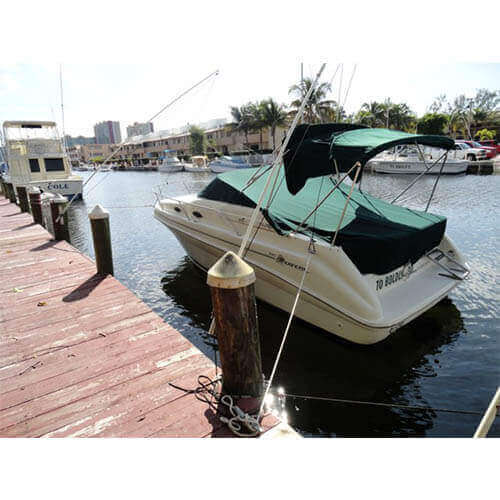Docking a Boat is Not Difficult
 Pulling into a crowded marina without knowing exactly how to maneuver your single screw boat is one of life’s least pleasant experiences. You’re convinced that all eyes are trained on you, and you may not be wrong.
Pulling into a crowded marina without knowing exactly how to maneuver your single screw boat is one of life’s least pleasant experiences. You’re convinced that all eyes are trained on you, and you may not be wrong.
A dual engine boat is easier to handle, so the conventional wisdom goes, because you can back one engine while putting the second in forward, thereby maneuvering around the most difficult obstacles. But docking a single engine boat is not difficult. Why are so many boaters intimidated by it? Boating is supposed to be fun.
The problem with docking a single engine boat is its simplicity. It has one propeller and that propeller moves the boat forward and reverse. The problem is compounded by the perception among boaters that a single screw boat is difficult to handle. Without the knowledge you will get from this article, you may be driving your boat by instinct, and steer into the dock at an angle, then swing your helm at the last moment, and hope that: a. you don’t collide with the dock; and b. that you don’t wind up too far away and have to try again. That maneuver is scary when the slip you’re aiming for is narrow and surrounded by other boats. It is made scarier because your pulse rate is up, and you’re emotionally invested in an action that should be simple.
The good news is that the idea that docking a single engine boat is difficult is simply wrong. The problem is that so many boaters make it complicated when it’s really simple. Remember the old philosophical principle called Occam’s Razor? It’s the theory that among all possible explanations for something, usually the simplest answer is the best. You don’t have to memorize a bunch of rules that you will forget as soon as you’re in a tight spot. So here is the simple answer to docking a single engine boat: These rules apply whether you own a high performance powerboat or a small flats boat.
1. The Stern Moves First.
You probably heard this when you first started boating but didn’t grasp its importance. If you operate a single screw boat, knowing this means everything. Consider posting it on your steering station. The stern moves first, both in forward AND reverse. Power boats seem to steer like cars. I use the word seem, because your senses tell you that the boat is acting like a car. You turn the wheel left and the bow turns left. But the bow only looks like it’s doing the turning; it’s not, the stern is in charge. The bow is moving because it’s being pushed that way by the propeller—on the stern, pushing the water against the rudder, and the stern moves first. Drill this into your brain so that you won’t have to think about it.
2. Forget the Throttle
All that you need to do with the throttle is to engage it at the lowest setting. Consider putting a sock or plastic cup over the throttle to remind you of this rule. The reason to forget the throttle is that it has little to do with getting you next to the dock, as you will see in the next rule.
3. The Maneuver —The Simplicity Continues
Pull your boat parallel to and a few feet from the dock. Yes, parallel, not angled into it. Next, put your helm all the way away from the dock. If the dock is to starboard turn the wheel to port, and vice versa for a portside approach. Now, put it in forward and slowly say “forward one thousand,” and then put it in neutral. Then immediately put it in reverse and say “reverse one thousand,” and put it in neutral again. Repeat this simple maneuver until you gently move the boat right next to the dock. You will notice an amazing thing. The boat appears to be pushed at the dock by some invisible hand. The short bursts of forward and reverse make for a smooth approach.
Source: Boating Magazine

